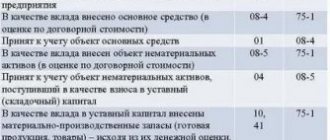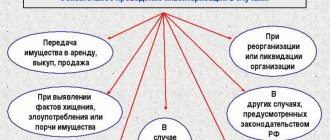What is meant by a contribution to the authorized capital and in what form is it paid for?
If you decide to create a business company, you will need knowledge of civil, accounting and tax legislation.
We will talk about its individual important norms in our article. The contribution to the authorized capital (VUC) refers to the following made by the founders or participants of a business company:
- money;
- non-monetary assets (shares of other business entities, intellectual rights, things, etc.)
Find out in what order the authorized capital of an LLC is paid in the Typical Situation from ConsultantPlus. Get free demo access to K+ and go to the material to find out all the details of this procedure.
VUK allows:
- ensure the activities of the company at the initial stage after creation or support its financial capabilities during operation (with an increase in the authorized capital);
- determine the amount of debt the company owes to each founder, received by him after leaving the ownership group (the actual value of the share);
- ensure the interests of the company's creditors;
- assess the necessary conditions for interaction between the company and the founders (determining the degree of participation of the founder in making management decisions based on the size of the VUC, establishing the procedure for distributing profits, etc.).
Payment of the authorized capital depends on the type of VUC:
- cash VUK are transferred to the company's current account or deposited in its cash desk.
- property VUCs are transferred to society according to a special algorithm (we will talk about this later).
Find out how a nominal share in the authorized capital differs from a real one from the article “Why is the authorized capital of an LLC needed and can it be spent?”
Stages of contributing property to the authorized capital
The procedure for entering VUK with property includes several stages:
- stage 1 - description in the constituent documents of the company of the possibility of entering the VUK with property and the procedure for carrying out this procedure;
- stage 2 - confirmation by the founder of the rights to the transferred property VUC;
- stage 3 - independent assessment of the transferred property;
- stage 4 - approval of the results of the assessment of the VUK by the founders (drawing up minutes of the general meeting of owners or other similar document);
- stage 5 - registration of the fact of transfer of property as a VUK (signing of the transfer and acceptance certificate);
- stage 6 - implementation of VUK accounting procedures in the tax and accounting system;
- stage 7 - the founders and the appraiser bear subsidiary liability for the unreliable amount of the property valuation.
In the following sections we will dwell in more detail on the individual features of this procedure.
What norm of the Civil Code of the Russian Federation should be taken into account in the procedure for a company to receive contributions to the authorized capital with property?
If you are establishing a business company, when forming the authorized capital, you must take into account the requirements of Art. 66.2 of the Civil Code of the Russian Federation - clause 2 of this article contains a rule on the mandatory payment in money of the minimum amount of the authorized capital.
Property contributions are permissible only in the remaining part of the authorized capital if it exceeds the minimum amount permitted by law.
Let's explain with an example:
In the constituent agreement of TSK Plus LLC, the size of the authorized capital is indicated as 100,000 rubles.
The founder of the company intended to contribute equipment as a VUK. Taking into account the norms of the Civil Code of the Russian Federation and the Law “On Limited Liability Companies” dated 02/08/1998 No. 14-FZ (hereinafter referred to as the LLC Law), he calculated the monetary and non-monetary components of the authorized capital:
VUK = DV + NDV,
100 000 = 10 000 + 90 000,
Where:
DV—minimum authorized capital for an LLC (Clause 1, Article 14 of the LLC Law);
NDV - the amount of the authorized capital minus the above minimum amount.
The founder formed the authorized capital in the following order:
- 10,000 rub. — transferred to the bank account of TSK Plus LLC;
- 90,000 rub. - transferred equipment to the company for this amount (after receiving an independent assessment of the value of this property and approval of the assessment results).
ConsultantPlus experts explained how to determine and approve the value of property contributed to the authorized capital of an LLC. If you do not have access to the K+ system, get a trial online access for free.
It is also necessary to pay special attention to the content of such a constituent document as the protocol (or decision) on the creation of the company.
As judicial practice shows (for example, the decision of the Arbitration Court of the Sverdlovsk Region dated 08/02/2016 in case No. A60-12861/2016), the absence in the decision to create a company of a description of the conditions for the formation of the authorized capital can lead to refusal of state registration of the company.
According to tax authorities and judges, such mandatory information includes the following information:
- on the size and nominal value of the founder’s share;
- the procedure and timing of payment of the authorized capital.
In such a situation, it will no longer matter in what form the VUC is contributed (property or money) - the possibility of the existence of society itself will be in question.
“Accounting” stage for property contribution
Property VUK reflect:
- in accounting - at the cost agreed by the founders (using posting Dt 75 “Settlements with founders” Kt 80 “Authorized capital”);
- in tax accounting - according to the tax accounting data of the transferring party.
A variety of property (fixed assets, inventories, goods, etc.) can act as a property asset, therefore, it is necessary to apply the appropriate accounting and tax accounting standards to the accounting of each individual type of property asset asset.
Let us consider, using an example, the features of the transfer by the founder and the receipt by the company in the form of a VUK of property that meets the criteria of a fixed asset:
LLC "X" received a used lathe from PJSC "U" as a VUK.
Initial data:
- the initial and residual cost of the machine, according to the transferring party, is 2.5 million rubles. and 1.8 million rubles. respectively;
- the size of the VUK according to the act of an independent appraiser and constituent documents - 2 million rubles;
- There are no additional expenses for the transfer of the machine as a VUK.
The following entries will be made in the accounting of the transferring party (PJSC “U”):
| Account correspondence | Amount, rub. | Content | |
| Debit | Credit | ||
| 58 | 76 | 2 000 000 | Reflection of debt on payment of authorized capital |
| 01 | 01 | 2 500 000 | Write-off of the initial cost of fixed assets transferred as VUK |
| 02 | 01 | 700 000 (2 500 000 – 1 800 000) | Write-off of accrued depreciation of a lathe |
| 76 | 01 | 1 800 000 | Write-off of the residual value of the machine |
| 19 | 68 | 324 000 (1 800 000 × 18%) | Recovering VAT from the residual value of the machine |
| 91 | 19 | 324 000 | Recovered VAT included in other expenses |
In the accounting of the receiving party (LLC “X”):
- debt to PJSC “U” under VUK: Dt 75 Kt 80 in the amount of 2 million rubles. (the value of the property VUK confirmed by an independent appraiser and approved by the founders).
- the cost of the machine received as a VUK is reflected by the posting: Dt 08 Kt 75 in the amount of 2 million rubles. (after putting the machine into operation: Dt 01 Kt 08).
How to show the authorized capital in the reporting, says the material “In which section is the authorized capital reflected in the balance sheet?”
Capital contribution. VAT deductible
Receiving property as a contribution to the authorized capital is a special operation. The founder must restore the “input” VAT on the transferred property. And the receiving party has the right to offset this tax. But only if certain requirements are met...
The company received fixed assets as a contribution to the authorized capital. When transferring the property, the founder did not highlight the restored VAT as a separate line in the accompanying documents. The accountant of the recipient company allocated the tax independently (at the estimated rate) and set it for deduction. What is the mistake
When making a contribution to the authorized capital of another company, invoices are not prepared. Indeed, according to the code, the transfer of property to the authorized capital is not recognized as a sale and is not subject to VAT (subclause 4, clause 3, article 39, subclause 1, clause 2, article 146 of the Tax Code of the Russian Federation). However, the legislation allows the receiving party to deduct the tax that was restored by the founder (clause 11 of Article 171 of the Tax Code of the Russian Federation).






